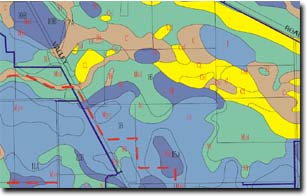2.2.1 - What soil type do I have?
Return to Main Menu | Return to Step 2 | Return to Step 2.2 | Next Step
It is important to understand the soil types on your farm as they have a major impact on the type of irrigation system best suited to your property. Soils are categorised into types based on soil profile features such as texture, colour, depth and topographical position in the landscape.
Detailed soil maps of the Shepparton Irrigation Region (SIR) categorise soil types into 6 soil groups based on their suitability for irrigation of various crops. Groups 1 and 2 are considered most suitable for horticulture crops, Groups 3 and 4 for pasture and shallow-rooting crops, Group 5 for summer fodder crops and annual pastures and Group 6 is not recommended for irrigation because of swampiness, liability to intermittent flooding and salinity. However most soils can be developed for irrigated agriculture given suitable crops, irrigation technology and drainage.
The published soil maps for the SIR are detailed and have extensive spatial coverage. You can visit the soil page on Victorian Resources Online (VRO) on the DEPI website to find out the soil types for your property as follows:
- VRO Regional soils information;
- Regional area information for example the Shepparton Irrigation Region (SIR) found in the Goulburn Broken region;
- Search for Detailed Soil Surveys;
- Soil and land survey for your area e.g. Murray Valley East;
- On the map showing the area covered by the particular soil survey, click on the grid square containing your property to open the soil map;
- Click on the thumbnail map to enlarge it, and then click on your area, OR
- Click on the soil survey for your area from the list eg Murray Valley East
- Note the soil type information e.g. ‘Mcl’;
- Go back to ‘legend’ and find out the soil type information e.g. Mcl is Muckatah clay loam, a Group 6 soil.

Example of magnified Regional soil map, showing detail
Soil types should be given due consideration when canvassing your irrigation system options. Most soils can be successfully irrigated with centre pivots but clay soils can have serious problems with wheel rutting. Alternatively, you can lose large amounts of water as deep seepage if you irrigate light soils by surface irrigation systems (such as border-check), particularly when poorly designed or not managed properly.


